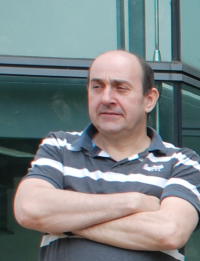Ibby completed a D.Phil. in Chem. Cryst. in 2002 working on clathrates of deoxycholic acid. He now works in Malaysia where he is the proud owner of a new diffractometer and visits Oxford when he can.
J. Appl. Cryst. (2006), 39, 842-849. Â Â [ doi:10.1107/S0021889806038489 ]
A sizeable proportion of structures with Z‘ = 2 are thought to exhibit pseudosymmetry, but establishing the extent of the deviation from true symmetry is problematic. By considering both the conformational similarity between the independent molecules and the way in which they are related in space, assessment of the pseudosymmetry of a structure becomes possible. A method of matching two groups of atoms where both these factors are quantified using CRYSTALS [Betteridge, Carruthers, Cooper, Prout & Watkin (2003). J. Appl. Cryst. 36, 1487] is described.
 Nick is Inorganic Nuclear Magnetic Resonance Manager. Although he comes from The Dark Side, solid state NMR has its uses and he not only works closely with us, but he is also continuing the work he carried out with Keith Prout on deoxycholic acid complexes. As such he is an honorary member of Chem. Cryst.
Nick is Inorganic Nuclear Magnetic Resonance Manager. Although he comes from The Dark Side, solid state NMR has its uses and he not only works closely with us, but he is also continuing the work he carried out with Keith Prout on deoxycholic acid complexes. As such he is an honorary member of Chem. Cryst.
J. Appl. Cryst. (2002), 35, 168-174. Â Â [ doi:10.1107/S0021889802000249 ]
Although non-merohedrally twinned crystal structures can normally be solved without difficulty, problems usually arise during refinement. Careful analysis of poorly fitting data reveals that they belong predominantly to certain distinct zones in which |Fo|2 is systematically larger than |Fc|2. In the computer program ROTAX, a set of data with the largest values of (|Fo2| – |Fc2|)/u(|Fo2|) is identified and their indices transformed by rotations or roto-inversions about possible direct- and reciprocal-lattice directions. Matrices that transform the indices of the poorly fitting data to integers are identified as possible twin laws.
Acta Cryst. (2000), B56, 747-749. Â Â [ doi:10.1107/S0108768100008466 ]
The reporting of Uequiv and its standard uncertainty has a chequered history. In spite of the recommendation of the IUCr Commission on Journals that authors use the definition of Uequiv of their own choice, possibly without standard uncertainties, there still seems to be some confusion amongst referees and editors about the status of this derived parameter. It is shown that neither of the common definitions are very useful, and that the standard uncertainty computed from the refinement normal matrix is almost worthless. A potential alternative derived parameter is proposed.
Acta Cryst. (1994), A50, 411-437.   [ doi:10.1107/S0108767393012784 ]
Each year, many single-crystal structure analyses are reported that show evidence of over- or under-refinement. Often, the refinement strategies have been naive or over-complex and alternative strategies might have been more effective. The many descriptions of crystallographic and numerical techniques suitable for assisting with the control of difficult refinements are distributed widely in the literature and so are not always easily accessible. Without being a review of these procedures (which would require a substantial book), this article attempts to list readily available procedures, together with a brief outline of their backgrounds and examples of their applications to organic and organometallic compounds. The analysis of extended-lattice materials (usually inorganic materials) often raises problems in addition to those covered here. The particular aim of this article is to remind the reader that X-ray structure analysis is a modelling process and that, while standard models may be adequate for most analyses, more care and imagination must be applied to the treatment of difficult cases. Principles of methods are described without detailed mathematical derivations, although sufficient references to the literature are provided to permit careful study. Future requirements for refinement processes are outlined, including the use of new machine architectures, applications of sparse-matrix methods and the development of expert systems.
Electronic reprints
- Oxford University Research Archive [direct pdf]
Publisher’s copy
Acta Cryst. (1979), A35, 698-699. Â Â [ doi:10.1107/S0567739479001613 ]
The truncated Chebyshev polynomial provides a reliable scheme for the automatic determination of empirical weights for least-squares structure refinement when the errors are a function of |Fo|.
J. Appl. Cryst. (1972), 5, 250.   [ doi:10.1107/S0021889872099996 ]
The principle of this apparatus is not new (Hope, 1971), but it is reported because of interest shown in its simplicity by visitors to this laboratory. Small samples of the solute are heated in a saturated solution in a poor solvent, and convection and diffusion used to convey the solute to a cooler region where it is deposited as single crystals.
Publisher’s copy